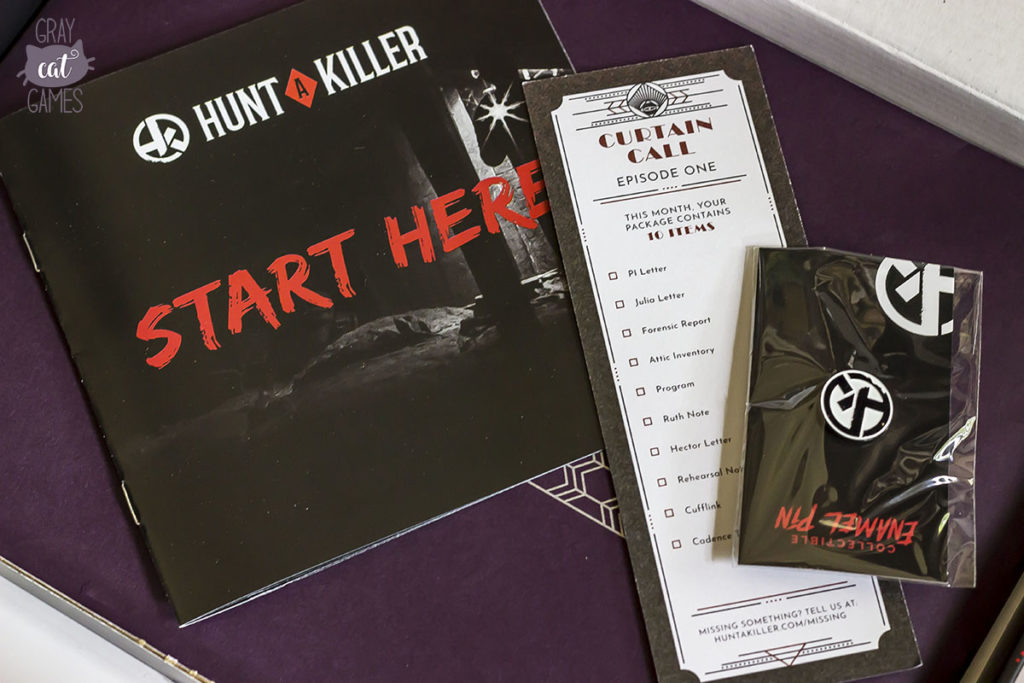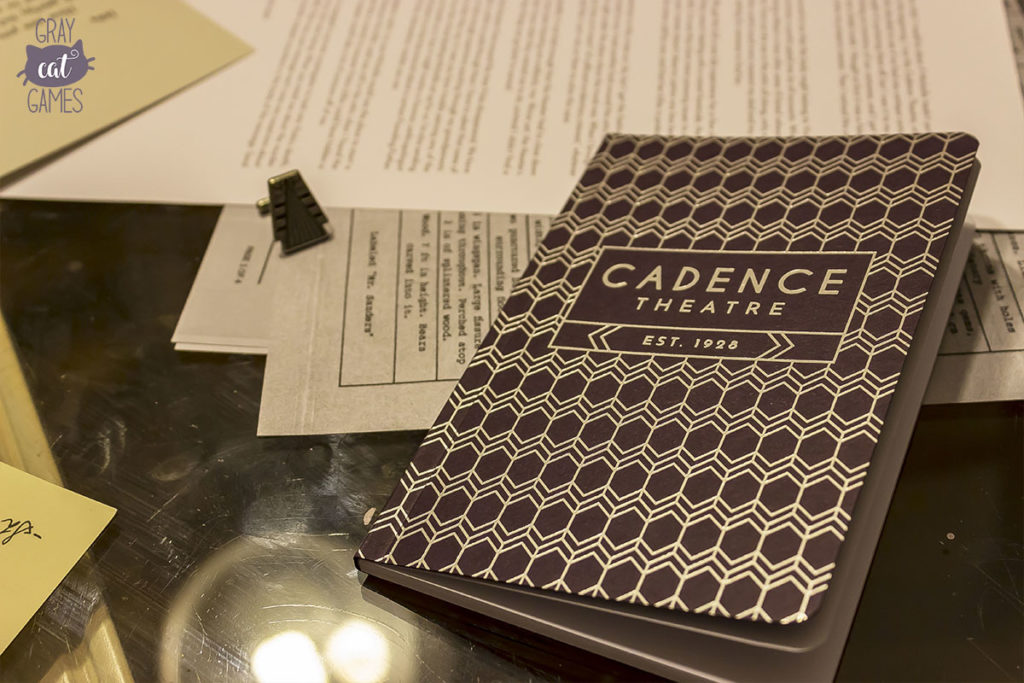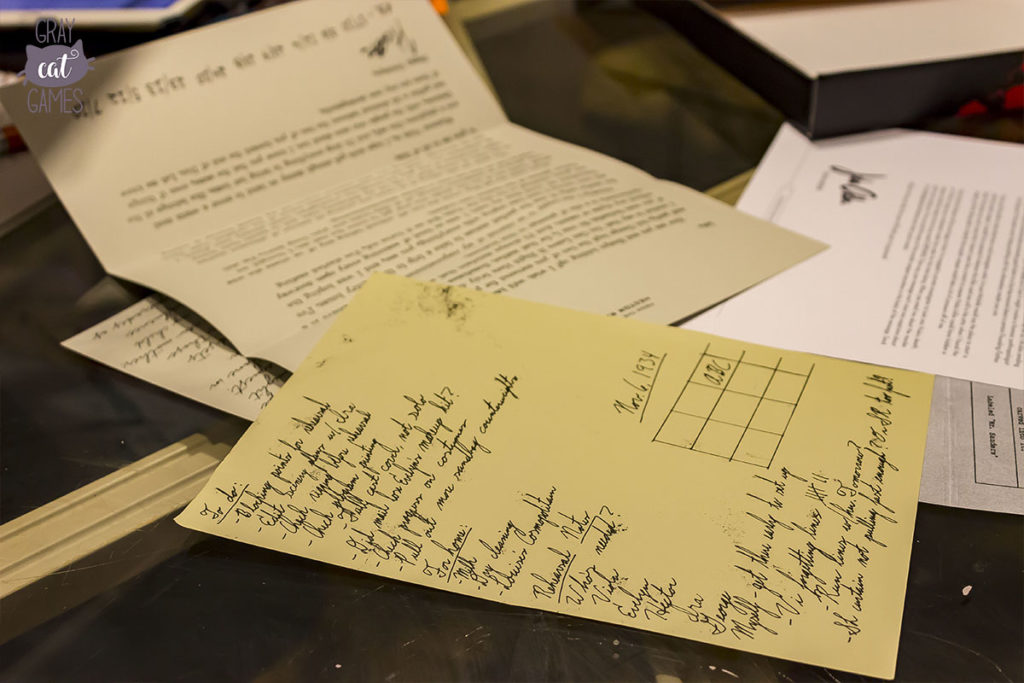Of all the genres of board games that we can tackle here, murder mysteries might be the most suited for a subscription box-type service. Mystery games in general are highly consumable, since once you’ve solved them, what else can you do? Games like Sherlock Holmes: Consulting Detective and Mythos Tales (check out this article to read more about these murder mystery games) can be highly engaging, while offering nothing if you want to return to them later.
These games are great, but it can be difficult for players to justify dropping the kind of “full board game money” on something you’ll only play once. So when the publisher of Hunt a Killer offered to send us a copy of their most recent series, we were very interested.
So let that be a disclaimer. We received this copy of the game for free in exchange for giving our impressions. If you are interested yourself, please note we also receive an affiliate commission. With that said, we’ve done our best to give you our complete impressions of the game, particularly with respect to whether we think it brings good value for the price. We were given the first 4 episodes of the series investigating the murder at the Cadence Theater.
Solving a Murder: Is Hunt a Killer Worth the Price of Entry?
First Impressions
Each month, subscribers get 1 episode of the current story. It comes in a small, low-profile black box covered in blood splatter. It’s pretty ominous, and a good way to set the tone of the murder you’ll be investigating.

The magic begins, though, when you open up that box and get a good look at the components. Our biggest first impression of episode 1 was just how nice the components are.

The typical package is a checklist helping you confirm you have everything for the episode, and an envelope holding all the goodies. For episode 1 of the Cadence Theater murder, this included handwritten letters, typed letters, a program book for a show, a cufflink belonging to one of the suspects, and a notebook that doubles as a guide for theater terms and concepts.
These are all very well done! It would be very easy to cheap out and just print everything on basic paper, or direct players to read materials off a website. But it feels great to hold a letter written in cursive in your hand, and it helps to provide the immersion you need in a game like this.
Meanwhile, there are online resources that you’ll be provided. Hunt a Killer goes the extra mile to provide higher-quality images (like autopsy photos) and transcriptions of the handwritten letters, in case you find the writing too messy to read.
The team clearly put a lot of work into the components for this content, and it makes the initial experience very smooth.

Gameplay Overview and Review
Much like other murder mystery games, you’re presented with one main goal: find the killer. Along the way, you’ll identify key pieces of evidence like the murder weapon through deduction based on documents you need to study.
In this way, Hunt a Killer plays out very much the same as games like Consulting Detective. Players sit and discuss, reading letters out loud, studying the notes and codes, and sharing what they’ve found out. The episode structure of the narrative is where Hunt a Killer starts to depart, however.
For starters, in episode 1 you are given a simple objective: identify the murder weapon. The second episode asks you to rule out someone from the suspect list, based on witness interviews. However, while playing, we noticed that we were being given a lot more information than necessary to solve the case.

For example, in episode 1, finding the murder weapon is as simple as reading the autopsy report and inventory of the Theater attic (in this specific scenario). You can knock that out very quickly. But in the meantime, you also have coded stage notes from one of the characters in the game. You also have coded letters and other kinds of clues that help you get an impression of these suspects.
In essence, you get a hint right from the start that there’s something pretty big going on, but you’re not asked to figure it all out at once. You’re given bite-sized objectives to solve, and once you have that, you can study the other materials to start getting at the bigger mysteries from the scenario. In our game, we started seeing tangled love affairs, people hiding things from each other, and a theater in deep financial trouble, suggesting motives.
As you loop in components of later scenarios, the narrative builds even more. We found this very interesting, since it allows you to direct how much of the story you want to take in, and at your own pace. Since you sit with each box for a month before the next episode, you have plenty of time to decipher the many coded messages and try to understand what they’re hinting at.
In all, we received the first 4 out of 6 episodes in the Cadence Theater Scenario. Completing the objectives in each one took us these lengths of time:
- Episode 1: 37 minutes
- Episode 2: 1 hour 25 minutes
- Episode 3: 52 minutes
- Episode 4: 32 minutes
Is It Worth the Money?
Looking at the time it took us to sit and play the objectives out, it might feel difficult to justify spending $25 per episode (if you’ve taken the year-long subscription). After all, if you focus on nothing else the objectives take only around 30 minutes.
But we want to emphasize that Hunt a Killer departs from other mystery board games here. The episodes aren’t really meant to be played in a single session, then put away to be forgotten about. Once you get the objective done, there is a lot more you can work at to find other pieces of the puzzle that will come into play later. This adds a lot to the game play, not to mention the discussions that can be sparked.
And this is where Hunt a Killer begins to assume a life of its own. If you’re playing with a partner, having that month to breathe between each scenario gives you time to sit and ruminate on what you’ve learned so far. In that way, it feels more like a real-life true crime mystery, where you don’t necessarily have all the details before the murder is solved. This gives you room to speculate.
Basically, Hunt a Killer starts to transcend just being a game. It gives you a shot at a truly immersive experience, one that no other board game we’ve ever played can replicate.
Who Would Like This Game?
In our opinion, if you’re a card-carrying member of the true crime fan club, then this kind of experience will be right up your alley. Sitting and pondering on the details of the case, only to see the clues unveiled slowly over time, is a national pastime at this point. This is true whether you’re a hardcore gamer or a non-gamer, too, since you don’t really need to deal with rules and points and other things that come with a traditional board game.
That said, it does take a certain mindset to enjoy this kind of game. First of all, if you need a board game to have a definitive beginning, middle, and end with each session, then this might leave you a bit dissatisfied. Each episode leaves a lot of narrative threads dangling in front of you. And that might be annoying to certain types of gamers who aren’t really looking for an immersive experience.
Furthermore, the objectives in Hunt a Killer are very accessible, so seasoned veterans of murder mystery games might find the tasks a little simple, given the clues you’re provided. We say this in contrast to something like Consulting Detective, which has conclusions that hinge on a tiny detail in an obscure page of newspaper you received 6 sessions ago to be able to solve.
This accessibility is a good thing for roping your non-gamer mother into the mix, but it’s going to feel a bit deflating for the pro. With that said, there’s so much else you can dive into and speculate on that you might be able to flex your deductive muscles and solve the mystery before all the clues are laid out in front of you. This means that, with a little more work, even the jaded veterans should get a big kick out of Hunt a Killer.
Also, it’s very much worth noting that unlike other legacy games and subscription box games we’ve tried, in our experience you can easily play this game without writing on or destroying any of the components. This means that you can re-pack the box and share it with friends, possibly helping to reduce the overall cost, as well.
Ultimately, the value proposition is up to you! If you want a strict board game like Azul, then go buy Azul. However, if you want to take part in a truly immersive experience, Hunt a Killer offers that in spades, and it can keep you and your group talking for months at a time. We have enjoyed our time with it, and we think you would too, if you’re into the murder mystery genre of board games.